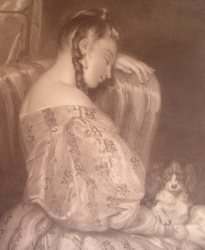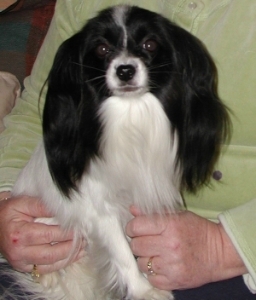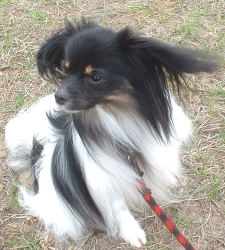|
 Successful breeding and exhibition of Phalenes can be a
challenge to the fanciers that adore this elegant, sweet,
expressive, and yet soulful little moth dog. A number of years
ago, the Phalenes popularity diminished to near extinction. Today
in the United States, Canada, and abroad there is a growing
interest in rebuilding the original butterfly dog’s gene pool.
The breeders, owners, and exhibitors of the Phalène not only must
love their soft charismatic charm, but also must serve as
ambassadors for the Phalène, educating judges, other Papillon
fanciers and dog lovers in general. Competition in the breed ring
is rather difficult at AKC shows. When it comes to being awarded
winning ribbons, there are few classes offered for the drop eared
Papillon at all breed shows. Judges are not as familiar with the
variety and will often pass by an equal or better quality Phalène.
Lack of Phalène education to promote the two breed varieties,
erect Successful breeding and exhibition of Phalenes can be a
challenge to the fanciers that adore this elegant, sweet,
expressive, and yet soulful little moth dog. A number of years
ago, the Phalenes popularity diminished to near extinction. Today
in the United States, Canada, and abroad there is a growing
interest in rebuilding the original butterfly dog’s gene pool.
The breeders, owners, and exhibitors of the Phalène not only must
love their soft charismatic charm, but also must serve as
ambassadors for the Phalène, educating judges, other Papillon
fanciers and dog lovers in general. Competition in the breed ring
is rather difficult at AKC shows. When it comes to being awarded
winning ribbons, there are few classes offered for the drop eared
Papillon at all breed shows. Judges are not as familiar with the
variety and will often pass by an equal or better quality Phalène.
Lack of Phalène education to promote the two breed varieties,
erect
 and drop eared, as equals in the AKC breed standard is
partly to blame. Judges that have settled into many years of
judging only Papillons can find it difficult to recognize and
reward the qualities of the Phalène. and drop eared, as equals in the AKC breed standard is
partly to blame. Judges that have settled into many years of
judging only Papillons can find it difficult to recognize and
reward the qualities of the Phalène.
A breed history showing the exact origin of the Phalène is not
exactly known, though there are several theories of where the
breed developed. The most popular belief states that the Phalène
began in France, Belgium and also Spain. Phalènes depicted as
royal pets in old master paintings showed they became popular in
European courts. They have been connected to many famous royal
names. A few recognizable names are: King Louis XIV, King Henry
III, Madame Pompadour, and Marie Antoinette.
 However vague the breed beginnings might be, one fact is
certain. The drop eared Phalène was the first variety of the
Butterfly dog. The Butterfly dog is also known as "The
Continental Toy Spaniel" (Epagneul Nain Continental). The AKC
breed standard lists the drop eared Phalène as an equal variety
to the more popularly known erect eared Papillon. The two
varieties are lumped together, and both the erect (Papillon) and
dropped (Phalène) are registered and compete as Papillons. The
drop eared variety in countries that follow FCI (Fédération
Cynologique Internationale) standards are separately registered as
Phalenes and compete as their own breed against only other
Phalenes. Evaluating and judging the Phalène is different, yet
the same as Papillons. With the exception of the drop ears and
slightly lifting ear carriage, the Phalène is identical However vague the breed beginnings might be, one fact is
certain. The drop eared Phalène was the first variety of the
Butterfly dog. The Butterfly dog is also known as "The
Continental Toy Spaniel" (Epagneul Nain Continental). The AKC
breed standard lists the drop eared Phalène as an equal variety
to the more popularly known erect eared Papillon. The two
varieties are lumped together, and both the erect (Papillon) and
dropped (Phalène) are registered and compete as Papillons. The
drop eared variety in countries that follow FCI (Fédération
Cynologique Internationale) standards are separately registered as
Phalenes and compete as their own breed against only other
Phalenes. Evaluating and judging the Phalène is different, yet
the same as Papillons. With the exception of the drop ears and
slightly lifting ear carriage, the Phalène is identical to the
Papillon in all other breed characteristics. to the
Papillon in all other breed characteristics.
The key to learn the correct Phalène ear is rather simple.
Visualize that the ears of the Phalène are like whimsical fringed
moths. Try to prevent from comparing the Phalène ears to the ears
of other spaniel breeds. The ear size, leather or placement on the
head of the Phalène is not to be compared to the drop ear of a
Cocker Spaniel, King Charles Cavalier, or the Japanese Chin.
Ear set is normally higher than other spaniel type drop eared
breeds, but lower and placed differently when comparing the
Phalène ear to the erect eared Papillon. To hold the Phalène
ears upright and
 compare them as a Papillon show ignorance when
evaluating the breed varieties. The rounded-fringed ears of the
adult Phalène should be thin but firm. The ears should appear to
have a slight lift for air ventilation with the ear set above
the
dogs eye line, but still low enough when observing the head from
the front to see a slight roundness to the top of the head. compare them as a Papillon show ignorance when
evaluating the breed varieties. The rounded-fringed ears of the
adult Phalène should be thin but firm. The ears should appear to
have a slight lift for air ventilation with the ear set above
the
dogs eye line, but still low enough when observing the head from
the front to see a slight roundness to the top of the head.
When considering the natural ear lift, mobility backwards,
mobility sideways, mobility out and mobility up are acceptable and
common ear movements as long as the ears when standing still or at
rest are down. A Phalène may have mobility in one ear or both. It
i s not unusual for the Phalenes ear to almost float in the breeze.
While the Phalène is moving, the ears often appear like a moth
fluttering in the air. The Phalène when looking up and back, as
when baiting at a toy held shoulder high, may also momentarily
flip their ears back and almost seem semi erect. It s not unusual for the Phalenes ear to almost float in the breeze.
While the Phalène is moving, the ears often appear like a moth
fluttering in the air. The Phalène when looking up and back, as
when baiting at a toy held shoulder high, may also momentarily
flip their ears back and almost seem semi erect. It
 is important
not to confuse the Phalene’s ear mobility with the half-erect or
tipped over (for example sheltie like) weak eared Papillon. The
young Phalène will tend to have more ear movement to lift their
ears. With time and maturity, the ears will settle more in
addition to the weight of adult ear fringing. is important
not to confuse the Phalene’s ear mobility with the half-erect or
tipped over (for example sheltie like) weak eared Papillon. The
young Phalène will tend to have more ear movement to lift their
ears. With time and maturity, the ears will settle more in
addition to the weight of adult ear fringing.
When looking from a distance, out at a ring that has both
Papillon and Phalenes competing, there can be an optical allusion
that makes the Phalène standing between two Papillons appear out
of balance. Using the table examination to evaluate the overall
body length compared to the h eight, plus feeling the length of
neck should find the required elegance is the same standard
requirements of slightly longer than tall. eight, plus feeling the length of
neck should find the required elegance is the same standard
requirements of slightly longer than tall.
Most important of all remember that the AKC breed standard
requires a small, friendly, elegant toy dog of fine-boned
structure, light, dainty and of lively action. While in the ring,
the Papillon can almost appear at times like a butterfly. Paps
will
 jump and turn, while their ears flitter and flutter forwards
and backwards. Don’t expect the Phalène variety to stand statue
still appearing dead eared while the Papillon competitors act like
butterflies. It is a promise; Phalenes carry the same delightful
spark in their eye that has affectionately gained the breed the
nickname of little tyrants. jump and turn, while their ears flitter and flutter forwards
and backwards. Don’t expect the Phalène variety to stand statue
still appearing dead eared while the Papillon competitors act like
butterflies. It is a promise; Phalenes carry the same delightful
spark in their eye that has affectionately gained the breed the
nickname of little tyrants.
| Thanks goes out to
Patti Hecht & "La Pacir
Amica Denim Dapper" for sharing
his pictures for this article. |
|